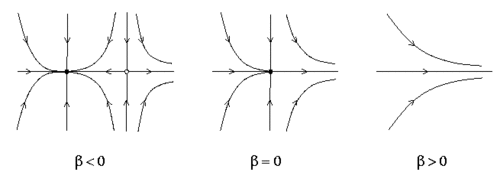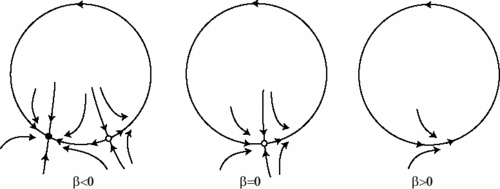
A saddle-node bifurcation is a collision and disappearance of two equilibria in dynamical systems. In systems generated by autonomous ODEs, this occurs when the critical equilibrium has one zero eigenvalue. This phenomenon is also called fold or limit point bifurcation. A discrete version of this bifurcation is considered in the article "Saddle-node bifurcation for maps".
Contents |
[edit] Definition
Consider an autonomous system of ordinary differential equations (ODEs) \[ \dot{x}=f(x,\alpha),\ \ \ x \in {\mathbb R}^n \] depending on a parameter \(\alpha \in {\mathbb R}\ ,\) where \(f\) is smooth.
- Suppose that at \(\alpha=0\) the system has an equilibrium \(x^0=0\ .\)
- Further assume that its Jacobian matrix \(A_0=f_x(0,0)\) has a simple eigenvalue \(\lambda_{1}=0 \ .\)
Then, generically, as \(\alpha\) passes through \(\alpha=0\ ,\) two equilibria collide, form a critical saddle-node equilibrium (case \(\beta=0\) in Figure 1), and disappear. This bifurcation is characterized by a single bifurcation condition \(\lambda_1=0\) (has codimension one) and appears generically in one-parameter families of smooth ODEs. The critical equilibrium \( x^0 \) is a multiple (double) root of the equation \( f(x,0)=0 \ .\)
[edit] One-dimensional Case
To describe the bifurcation analytically, consider the system above with \(n=1\ ,\)\[ \dot{x} = f(x,\alpha), \ \ \ x \in {\mathbb R} \ .\] If the following nondegeneracy conditions hold:
- (SN.1) \(a(0)=\frac{1}{2}f_{xx}(0,0) \neq 0\ ,\)
- (SN.2) \(f_{\alpha}(0,0) \neq 0\ ,\)
then this system is locally topologically equivalent near the origin to the normal form \[ \dot{y} = \beta + \sigma y^2 \ ,\] where \(y \in {\mathbb R},\ \beta \in {\mathbb R}\ ,\) and \(\sigma= {\rm sign}\ a(0) = \pm 1\ .\)
The normal form has two equilibria (one stable and one unstable) \(y^{1,2}=\pm \sqrt{-\sigma \beta}\) for \(\sigma \beta<0\) and no equilibria for \(\sigma \beta > 0\ .\) At \(\beta=0\ ,\) there is one critical equilibrium \(y^0=0\) with zero eigenvalue.
[edit] Multidimensional Case
In the \(n\)-dimensional case with \(n \geq 2\ ,\) the Jacobian matrix \(A_0\) at the saddle-node bifurcation has
- a simple zero eigenvalue \(\lambda_{1}=0\ ,\) as well as
- \(n_s\) eigenvalues with \({\rm Re}\ \lambda_j < 0\ ,\) and
- \(n_u\) eigenvalues with \({\rm Re}\ \lambda_j > 0\ ,\)
with \(n_s+n_u+1=n\ .\) According to the Center Manifold Theorem, there is a family of smooth one-dimensional invariant manifolds \(W^c_{\alpha}\) near the origin. The \(n\)-dimensional system restricted on \(W^c_{\alpha}\) is one-dimensional, hence has the normal form above.
Moreover, under the non-degeneracy conditions (SN.1) and (SN.2), the \(n\)-dimensional system is locally topologically equivalent near the origin to the suspension of the normal form by the standard saddle, i.e. \[ \dot{y} = \beta + \sigma y^2 \ ,\] \[ \dot{y}^s = -y^s \ ,\] \[ \dot{y}^u = +y^u \ ,\] where \(y \in {\mathbb R}\ ,\) \(y^s \in {\mathbb R}^{n_s}, \ y^u \in {\mathbb R}^{n_u}\ .\) Figure 1 shows the phase portraits of the normal form suspension when \(n=2\ ,\) \(n_s=1\ ,\) \(n_u=0\ ,\) and \(\sigma=+1\ .\)
[edit] Quadratic Coefficient
The quadratic coefficient \(a(0)\ ,\) which is involved in the nondegeneracy condition (SN.1), can be computed for \(n \geq 1\) as follows. Write the Taylor expansion of \(f(x,0)\) at \(x=0\) as \[ f(x,0)=A_0x + \frac{1}{2}B(x,x) + O(\|x\|^3) \ ,\] where \(B(x,y)\) is the bilinear function with components \[ \ \ B_j(x,y) =\sum_{k,l=1}^n \left. \frac{\partial^2 f_j(\xi,0)}{\partial \xi_k \partial \xi_l}\right|_{\xi=0} x_k y_l \ ,\] where \(j=1,2,\ldots,n\ .\) Let \(q\in {\mathbb R}^n\) be a null-vector of \(A_0\ :\) \(A_0q=0, \ \langle q, q \rangle =1\ ,\) where \(\langle p, q \rangle = p^Tq\) is the standard inner product in \({\mathbb R}^n\ .\) Introduce also the adjoint null-vector \(p \in {\mathbb R}^n\ :\) \(A_0^T p = 0, \ \langle p, q \rangle =1\ .\) Then (see, for example, Kuznetsov (2004)) \[ a(0)= \frac{1}{2} \langle p, B(q,q))\rangle = \left.\frac{1}{2} \frac{d^2}{d\tau^2} \langle p, f(\tau q,0) \rangle \right|_{\tau=0} \ .\] Standard bifurcation software (e.g. MATCONT) computes \(a(0)\) automatically.
[edit] Other Cases
Saddle-node bifurcation occurs also in infinitely-dimensional ODEs generated by PDEs and DDEs, to which the Center Manifold Theorem applies. Saddle-node bifurcations occur also for dynamical systems with discrete time (iterated maps).
[edit] Saddle-Node Homoclinic Bifurcation
An important case of saddle-node bifurcation in planar ODEs is when the center manifold makes a homoclinic loop, as in the Figure 3. Such a saddle-node homoclinic bifurcation results in the birth of a limit cycle when the saddle-node disappears. The period of this cycle tends to infinity as the parameter approaches its bifurcation value. In ODEs with \( n \geq 3 \ ,\) a saddle-node with \( n_sn_u >0 \) can have more than one homoclinic orbit simultaneously. Disappearance of such a saddle-node, called a saddle-saddle or a Shilnikov saddle-node, generates an infinite number of saddle periodic orbits.
[edit] References
- A.A. Andronov, E.A. Leontovich, I.I. Gordon, and A.G. Maier (1971) Theory of Bifurcations of Dynamical Systems on a Plane. Israel Program Sci. Transl.
- L.P. Shilnikov, On a new type of bifurcation in multidimensional dynamical systems (1969) Sov Math Dokl. 10, 1368-1371.
- V.I. Arnold (1983) Geometrical Methods in the Theory of Ordinary Differential Equations. Grundlehren Math. Wiss., 250, Springer
- J. Guckenheimer and P. Holmes (1983) Nonlinear Oscillations, Dynamical systems and Bifurcations of Vector Fields. Springer
- Yu.A. Kuznetsov (2004) Elements of Applied Bifurcation Theory, Springer, 3rd edition.
- S. Newhouse, J. Palis and F. Takens (1983) Bifurcations and stability of families of diffeomorphisms. Inst. Hautes Études Sci. Publ. Math. 57, 5-71.
- L.P. Shilnikov, A.L. Shilnikov, D.V. Turaev, and L.O. Chua (2001) Methods of Qualitative Theory in Nonlinear Dynamics. Part II, World Scientific.
Internal references
- Yuri A. Kuznetsov (2006) Andronov-Hopf bifurcation. Scholarpedia, 1(10):1858.
- Jack Carr (2006) Center manifold. Scholarpedia, 1(12):1826.
- Willy Govaerts, Yuri A. Kuznetsov, Bart Sautois (2006) MATCONT. Scholarpedia, 1(9):1375.
- James Murdock (2006) Normal forms. Scholarpedia, 1(10):1902.
- Jeff Moehlis, Kresimir Josic, Eric T. Shea-Brown (2006) Periodic orbit. Scholarpedia, 1(7):1358.
- Philip Holmes and Eric T. Shea-Brown (2006) Stability. Scholarpedia, 1(10):1838.
[edit] External Links
[edit] See Also
Andronov-Hopf bifurcation, Bifurcations, Center manifold theorem, Dynamical systems, Equilibria, MATCONT, Ordinary differential equations, Saddle-node bifurcation for maps, Saddle-node homoclinic bifurcation, XPPAUT

